List of bioluminescent fungi

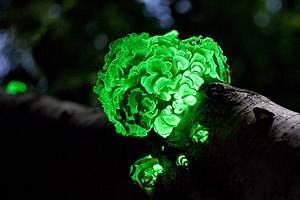
Found largely in temperate and tropical climates, currently there are more than 125 known species of bioluminescent fungi,[1] all of which are members of the order Agaricales (Basidiomycota) with one possible exceptional ascomycete belonging to the order Xylariales.[2][NB 1] All known bioluminescent Agaricales are mushroom-forming, white-spored agarics that belong to four distinct evolutionary lineages. The Omphalotus lineage (comprising the genera Omphalotus and Neonothopanus) contains 12 species, the Armillaria lineage has 10 known species, while the Mycenoid lineage (Favolachia, Mycena, Panellus, Prunulus, Roridomyces) has more than 50 species. The recently discovered Lucentipes lineage contains two species, Mycena lucentipes and Gerronema viridilucens, which belong to a family that has not yet been formally named.[4] Armillaria mellea is the most widely distributed of the luminescent fungi, found across Asia, Europe, North America, and South Africa.[5]
Adding to these, the newly discovered Eoscyphella lineage, represented by Eoscyphella luciurceolata from the Atlantic Rainforest in southern Brazil, marks a significant expansion in our understanding of fungal bioluminescence.[6]
Bioluminescent fungi emit a greenish light at a wavelength of 520–530 nm. The light emission is continuous and occurs only in living cells.[7] No correlation of fungal bioluminescence with cell structure has been found. Bioluminescence may occur in both mycelia and fruit bodies, as in Panellus stipticus and Omphalotus olearius, or only in mycelia and young rhizomorphs, as in Armillaria mellea.[8] In Roridomyces roridus luminescence occurs only in the spores, while in Collybia tuberosa, it is only in the sclerotia.[9]
Although the biochemistry of fungal bioluminescence has not fully been characterized, the preparation of bioluminescent, cell-free extracts has allowed researchers to characterize the in vitro requirements of fungal bioluminescence. Experimental data suggest that a two-stage mechanism is required. In the first, a light-emitting substance (called "luciferin") is reduced by a soluble reductase enzyme at the expense of NAD(P)H. In the second stage, reduced luciferin is oxidized by an insoluble luciferase that releases the energy in the form of bluish-green light. Conditions that affect the growth of fungi, such as pH, light and temperature, have been found to influence bioluminescence, suggesting a link between metabolic activity and fungal bioluminescence.[9]
All bioluminescent fungi share the same enzymatic mechanism, suggesting that there is a bioluminescent pathway that arose early in the evolution of the mushroom-forming Agaricales.[4] All known luminescent species are white rot fungi capable of breaking down lignin, found in abundance in wood. Bioluminescence is an oxygen-dependent metabolic process and therefore may provide antioxidant protection against the potentially damaging effects of reactive oxygen species produced during wood decay.
The physiological and ecological function of fungal bioluminescence has not been established with certainty. It has been suggested that in the dark beneath closed tropical forest canopies, bioluminescent fruit bodies may be at an advantage by attracting grazing animals (including insects and other arthropods) that could help disperse their spores. Conversely, where mycelium (and vegetative structures like rhizomorphs and sclerotia) are the bioluminescent tissues, the argument has been made that light emission could deter grazing.[9]
The following list of bioluminescent mushrooms is based on a 2008 literature survey by Dennis Desjardin and colleagues,[10] in addition to accounts of several new species published since then.[11][12][13][14]
Species
Key
- Binomial
- The binomial name of the fungal species, including the author citation—the person who first described the species using an available scientific name, using standardized abbreviations.
- Luminescence
- Indicates which form of the fungus—mycelium or fruit body—produces luminescence.
- Distribution
- The geographical distribution of the species. AF = Africa; AS = Asia; AU = Australasia; CA = Central America and the Caribbean; EU = Europe; NA = North America; SA = South America.
- References
- Literature sources where bioluminescence was reported.









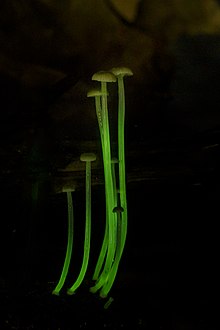
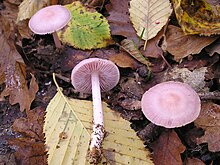
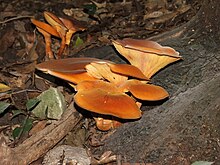

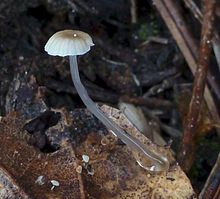
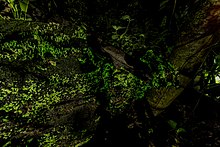

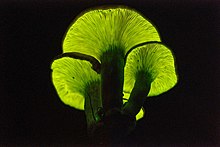
| Binomial | Luminescence | Distribution | References | |
|---|---|---|---|---|
| Mycelium | Fruit body | |||
| Armillaria calvescens Bérubé & Dessur. |
Yes | ? | Eastern NA | [16] |
| Armillaria cepistipes Velen. |
Yes | ? | NA, Eurasia | [16] |
| Armillaria fuscipes Petch |
Yes | No | Malaysia, Africa | [8][17][18] |
| Armillaria gallica Marxm. & Romagn. |
Yes | No | EU, NA, Africa, Japan | [19] |
| Armillaria gemina Bérubé & Dessur. |
Yes | ? | Eastern NA | [16] |
| Armillaria limonea (G.Stev.) Boesew. |
No | Yes | Australasia, SA | [15] |
| Armillaria mellea (Valh.) P.Kumm. |
Yes | No | Eurasia, NA | [19][20] |
| Armillaria nabsnona T.J. Volk & Burds. |
Yes | ? | Western NA, Asia | [16] |
| Armillaria novae-zelandiae (G.Stev.) Boesew. |
No | Yes | NZ, Australia, New Guinea, SA | [15] |
| Armillaria ostoyae (Romagn.) Henrik |
Yes | No | EU, NA | [21] |
| Armillaria sinapina Bérubé & Dessur. |
Yes | ? | NA, Asia | [16] |
| Armillaria tabescens (Scop.) Emel |
Yes | No | EU, NA | [19] |
| Collybia tuberosa (Bull.) P. Kumm |
No | Only sclerotia | EU, NA, Lithuania | [22][23] |
| Cruentomycena orientalis Har. Takah., Taneyama & Hadano |
Yes | Yes | Japan, Taiwan | [24] |
| Desarmillaria ectypa (Fr.) R.A. Koch & Aime |
Yes | Yes (gills) | EU | [25] |
| Dictyopanus foliicolus Kobayasi[a] |
Yes | Yes | Japan | [27][28] |
| Eoscyphella luciurceolata Silva-Filho, Stevani & Desjardin |
No | Yes | Brazil | [6] |
| Favolaschia manipularis (Berk.) Teng[b] |
? | Yes | Malaysia, Pacific islands | [30][31] |
| Favolaschia tonkinensis (Pat.) Kuntze, 1898 |
No | Yes | Eastern India, China (Yunnan) | [32] |
| Filoboletus hanedae (as 'hanedai′) Kobayasi[c] |
? | Yes | Japan | [27] |
| Filoboletus pallescens (Boedijn) Maas Geest. |
? | Yes | Malaysia, Indonesia (Krakatoa) | [34] |
| Favolaschia peziziformis (Berk. & M.A.Curtis) Sacc. |
? | Yes | Japan | [35] |
| Filoboletus yunnanensis P.G.Liu |
? | Yes | China | [34] |
| Gerronema viridilucens Desjardin, Capelari & Stevani |
Yes | Yes | SA | [36] |
| Marasmiellus venosus Har. Takah., Taneyama & Hadano |
No | Yes | Japan | [37][failed verification] |
| Mycena aspratilis Maas Geest. & de Meijer |
? | Yes (Hymenophore) | SA | [11] |
| Mycena asterina Desjardin, Capelari & Stevani |
Yes | Yes | SA | [38] |
| Mycena cahaya A.L.C.Chew & Desjardin |
Yes | Yes | Malaysia | [39] |
| Mycena citricolor (Berk. & M.A.Curtis) Sacc. |
Yes | No | SA, CA, Jamaica, El Salvador, Guatemala, Mexico, Puerto Rico | [18][40] |
| Mycena chlorophos (Berk. & M.A.Curtis) Sacc. |
Yes | Yes | Malaysia, Indonesia, Japan, Pacific Islands | [31] |
| Mycena cristinae J.S. Oliveira |
Yes | Yes | Brazil | [1] |
| Mycena crocata
(Schrad.) P. Kumm. |
Yes | No | Europe | [41][42] |
| Mycena coralliformis A.L.C. Chew & Desjardin |
Yes | ? | Malaysia | [30] |
| Mycena daisyogunensis Kobayasi |
? | Yes | Japan | [27] |
| Mycena deeptha Aravind. & Manim. |
Yes | No | India, Malaysia | [13] |
| Mycena deformis Maas Geest. & de Meijer |
Yes | No | Brazil | [43] |
| Mycena deusta Maas Geest. & de Meijer |
? | Yes | Brazil | [44] |
| Mycena discobasis Metrod |
? | Yes | SA, AF | [38] |
| Mycena sp. "Erua (PDD 80772)" | Yes | Yes | NZ | [45][46] |
| Mycena epipterygia (Scop.: Fr.) S.F.Gray |
Yes | No | EU, NA, Japan | [43] |
| Mycena fera Maas Geest. & de Meijer |
? | Yes | SA | [38] |
| Mycena flammifera Har. Takah. & Taneyama |
? | Yes | Japan | [47] |
| Mycena fulgoris Cortés-Pérez, Desjardin |
No | Yes (stipe) | Mexico | [48] |
| Mycena fusca Cleland |
? | ? | South Australia | [49] |
| Mycena galopus (Pers.: Fr.) P.Kumm. |
Yes | No | EU, NA, Japan | [18][41][43][50] |
| Mycena globulispora Maas Geest. & de Meijer |
Yes | Yes (basidiomes) | Brazil | [51] |
| Mycena gombakensis A.L.C. Chew & Desjardin |
Yes | Yes | Malaysia | [30] |
| Mycena guzmanii Cortés-Pérez, Desjardin |
Yes | Yes | Mexico | [48] |
| Mycena haematopus (Pers.: Fr.) P.Kumm. |
Yes | Yes | EU, NA, Japan | [41][50][52] |
| Mycena illuminans Henn. |
Yes | Yes | Malaysia, Japan | [30][31][53][54] |
| Mycena inclinata (Fr.) Quél. |
Yes | No | EU, NA, AF | [17] |
| Mycena jingyinga C.C. Chang, C.Y. Chen, W.W. Lin & H.W. Kao |
Yes | No | Taiwan | [55] |
| Mycena kentingensis Y.S. Shih, C.Y. Chen, W.W. Lin & H.W. Kao |
? | Yes | Taiwan | [14] |
| Mycena lacrimans Singer |
? | Yes | SA (Brazil) | [38] |
| Mycena lazulina Har. Takah., Taneyama, Terashima & Oba |
? | Yes | Japan, Taiwan, Vietnam, Australia | [56] |
| Mycena lucentipes Desjardin, Capelari & Stevani |
Yes | Yes | SA, CA | [38] |
| Mycena luguensis C.C. Chang, C.Y. Chen, W.W. Lin & H.W. Kao |
Yes | No | Taiwan | [55] |
| Mycena lumina Cortés-Pérez, Desjardin |
No | Yes | Mexico | [48] |
| Mycena lux-coeli Corner |
? | Yes | Japan | [31] |
| Mycena luxaeterna B.A.Perry & Desjardin |
Yes | Yes | SA | [11] |
| Mycena luxarboricola B.A.Perry & Desjardin |
No | Yes | SA | [11] |
| Mycena luxfoliata Har. Takah., Taneyama & Terashima |
Yes | No | Japan | [51] |
| Mycena luxfoliicola Cortés-Pérez, Desjardin & Ram.-Cruz |
Yes | Yes | Mexico | [48] |
| Mycena luxperpetua B.A. Perry & Desjardin |
Yes | Yes | Puerto Rico | [11] |
| Mycena maculata P.Karst. |
Yes | ? | EU, NA, AF | [50] |
| Mycena margarita (Murrill) Murrill |
? | Yes (yellowish green light in all parts of the basidiome, or nonluminescent in some populations) | Caribbean - Florida (USA), Belize, Jamaica, Dominican Republic, Puerto Rico, Trinidad, Venezuela, Brazil | [57][11] |
| Mycena nebula Cortés-Pérez, Desjardin & Rockefeller |
No | Yes | Mexico | [48] |
| Mycena nocticaelum A.L.C. Chew & Desjardin |
Yes | Yes | Malaysia | [30] |
| Mycena noctilucens Kawam. ex Corner[d] |
? | Yes | Malaysia, Pacific islands, South Solomons | [31][54] |
| Mycena olivaceomarginata (Massee apud Cooke) Massee |
Yes | No | EU, NA | [17] |
| Mycena oculisnymphae Desjardin, B.A. Perry & Stevanir |
? | Yes (basidiome) | Brazil | [51] |
| Mycena perlae Cortés-Pérez, Desjardin & Rockefeller |
No | Yes | Mexico | [48] |
| Mycena polygramma (Bull.: Fr.) S.F.Gray |
Yes | No | AF, EU, NA, Japan | [18][43][50] |
| Mycena pruinosoviscida Corner[e] |
? | Yes (and spores) | AU, Malaysia, Japan (Hachijō-jima) | [31][54] |
| Mycena pseudostylobates Kobayasi |
Yes | ? | Japan | [27] |
| Mycena pura (Pers.: Fr.) P.Kumm. |
Yes | No | EU, NA, SA, Japan | [50] |
| Mycena rosea (Bull.) Gramberg |
Yes | No | EU | [50] |
| Mycena roseoflava (G.Stev.) |
Yes | Yes | NZ | [15] |
| Mycena sanguinolenta (Alb. & Schwein.: Fr.) P.Kumm. |
Yes | No | EU, NA, Japan | [41][43] |
| Mycena seminau A.L.C.Chew & Desjardin |
Yes | Yes | Malaysia | [39] |
| Mycena silvaelucens B.A.Perry & Desjardin |
? | Yes (pileus, lamellae, stipe) | Malaysia | [11] |
| Mycena sinar A.L.C.Chew & Desjardin |
Yes | Yes | Malaysia | [39] |
| Mycena sinar var. tangkaisinar A.L.C.Chew & Desjardin |
? | Yes | Malaysia | [30] |
| Mycena singeri Lodge |
? | Yes | SA, CA | [38] |
| Mycena stellaris Har.Takah., Taneyama & Hadano |
? | Yes | Taiwan | [59] |
| Mycena stylobates (Pers.: Fr.) P.Kumm. |
Yes | No | AF, EU, NA, Japan | [41][43] |
| Mycena sublucens Corner |
No | Yes | Malaysia | [31] |
| Mycena tintinnabulum (Fr.) Quél. |
Yes | No | EU | [60] |
| Mycena venus C.C. Chang, C.Y. Chen, W.W. Lin & H.W. Kao |
Yes | No | Taiwan | [55] |
| Mycena vinacea Cleland |
? | Yes (basidiomes) | AU, NZ | [15] |
| Mycena zephirus (Fr.: Fr.) P.Kumm. |
Yes | No | EU | [43][50] |
| Neonothopanus gardneri (Berk. ex Gardner) Capelari, Desjardin, Perry, Asai & Stevani |
Yes | Yes | SA | [12][61] |
| Neonothopanus nambi (Speg.) Petersen & Krisai-Greilhuber |
Yes | Yes | AU, SA, CA, Malaysia | [30][62] |
| Nothopanus eugrammus (Mont.) Singer[f] |
No | Yes | Japan, Malaysia, Singapore | [62] |
| Nothopanus noctilucens (Lév.) Singer |
? | Yes | Japan | [64][65] |
| Omphalotus flagelliformis Zhu L. Yang & B. Feng |
Yes | Yes | China | [66] |
| Omphalotus illudens (Schwein.) Bresinsky & Besl. |
Yes | Yes | EU, NA | [8][17][18] |
| Omphalotus japonicus (Kawam.) Kirchm. & O.K.Mill.[g] |
Yes | Yes | China, Korea, Japan, Taiwan | [52][68][69][70] |
| Omphalotus mangensis (J.Li & X.Hu) Kirchm. & O.K.Mill. |
? | Yes | China | [71] |
| Omphalotus nidiformis (Berk.) O.K.Mill. |
? | Yes | AU | [72][73] |
| Omphalotus olearius (DC.: Fr.) Singer |
Yes | Yes | EU, US | [17] |
| Omphalotus olivascens H.E.Bigelow, O.K.Mill. & Thiers |
No | Yes | NA | [74] |
| Omphalotus subilludens (Murrill) H.E.Bigelow |
Yes | Yes | US | [75] |
| Panellus luminescens (Corner) Corner |
Yes | Yes | Malaysia | [30][76][77] |
| Panellus luxfilamentus A.L.C. Chew & Desjardin |
Yes | ? | Malaysia | [30] |
| Panellus pusillus (Pers. ex Lév.) Burdsall & O.K.Mill.[h] |
Yes | Yes | AF, AU, NA, SA, Malaysia, Japan | [28][31][65][77][79] |
| Panellus stipticus (Bull.: Fr.) P.Karst. |
Yes | Yes | AU, AF, EU, NA, SA, Japan | [18][80][20] |
| Pleurotus decipiens Corner |
? | Yes | Malaysia | [62] |
| Resinomycena petarensis Desjardin, B.A. Perry & Stevani |
Yes | No | Brazil | [51] |
| Roridomyces irritans (E.Horak) Rexer |
No | Yes | AU | [81] |
| Roridomyces phyllostachydis Karun., Mortimer and Axford |
No | Yes | India | [82] |
| Roridomyces pruinosoviscidus A.L.C. Chew & Desjardin |
Yes | Yes | Malaysia, Bismark Archipelago | [30] |
| Roridomyces lamprosporus (Corner) Rexer[i] |
No | Yes (spores) | Malaysia, AU | [54][76][81] |
| Roridomyces roridus (Fr.) Rexer[j] |
Yes | No | EU, NA, SA, Japan | [86] |
| Roridomyces sublucens Corner |
No | Yes (stipe and gills) | Amboina (Indonesia) | [87] |
| Roridomyces viridiluminus L.A.P. Dauner, Karunarathna & P.E. Mortimer |
Yes | Yes | China (Yunnan) | [87] |
| Tricholoma sciodes (Pers.) C. Martín |
Yes | No | Lithuania | [23] |
| Xylaria hypoxylon (L.) Grev. |
? | Allegedly (?)[NB 1] | EU | [88][20] |
See also
Notes
- ^ Apparently it is the same species as given in Index Fungorum with a current name as Dictyopanus foliicola Kobayasi.[26]
- ^ This species is given in Audrey et al. (2015) as Filoboletus manipularis and in Corner (1954) as Mycena manipularis var. microporus, but Index Fungorum indicates that Favolaschia manipularis is the current name.[29]
- ^ This species is given in Kobayasi (1951) as Poromycena hanedae (as ′hanedai′) but Index Fungorum indicates that Filoboletus hanedae (as ′hanedai′) is the current name.[33]
- ^ This species is presumably given in Corner (1994) as Mycena Noctilucens var. magnispora but Index Fungorum indicates that Mycena Noctilucens is the current name.
- ^ This species is given in Corner (1954) and presumably in Corner (1994) as Mycena pruinoso-viscida and Mycena pruinoso-viscida var. rabaulensis but Index Fungorum indicates that Mycena pruinosoviscida is the current name.[58]
- ^ This species is given in Corner (1981) as Pleurotus eugrammus var. radicicolus, but Index Fungorum indicates that Nothopanus eugrammus is the current name.[63]
- ^ This species is given in Zang (1979) as Lampteromyces luminescens, but Index Fungorum indicates that Omphalotus japonicus is the current name.[67]
- ^ This species is given in Corner (1954) as Dictyopanus pusillus var. sublamellatus and in Kobayasi (1963), Corner (1954), Corner (1986) as Panellus gloeocystidiatus but Index Fungorum indicates that Panellus pusillus is the current name.[78]
- ^ This species is given in Corner (1994), Corner (1950), Horak (1978) as Mycena lamprospora, but Index Fungorum indicates that Roridomyces lamprosporus is the current name.[83]
- ^ This species is given in Desjardin et al. (2008) as Mycena rorida, but both Index Fungorum and MycoBank indicate that Roridomyces roridus is the current name.[84][85]
- ^ a b Xylaria hypoxylon is indeed identified as bioluminescent in some sources; the light is said to be extremely faint, however.[3][wb 1]
Subnotes
- ^ See photos here: Cann, AJ (2017-12-19). "Candlesnuff Luminescence". NatureSpot. Archived from the original on 2023-06-20.
References
- ^ Stevani, C. V., Zamuner, C. K., Bastos, E. L., de Nóbrega, B. B., Soares, D. M. M., Oliveira, A. G., Bechara, E. J. H., Shakhova, E. S., Sarkisyan, K. S., Yampolsky, I. V., & Kaskova, Z. M. (2024). The living light from fungi. Journal of Photochemistry and Photobiology C: Photochemistry Reviews, 58, 100654.
- ^ Seas-Carvajal C, Avalos G (2013). "Distribution of bioluminescent fungi across old-growth and secondary tropical rain forest in Costa Rica" (PDF). Revista de Biologia Tropical. 61 (2): 531–537. PMID 23885571.
- ^ O'Reilly, Pat (2024-09-11). "Xylaria hypoxylon (L.) Grev. – Candlesnuff Fungus". First Nature (Fascinated by Fungi). Archived from the original on 2024-05-27.
- ^ a b Oliveira AG, Desjardin DE, Perry BA, Stevani CV (2012). "Evidence that a single bioluminescent system is shared by all known bioluminescent fungal lineages" (PDF). Photochemical & Photobiological Sciences. 11 (2): 848–852. Bibcode:2012PhPhS..11..848O. doi:10.1039/c2pp25032b. PMID 22495263. S2CID 205831865.
- ^ Vydryakova GA, Psurtseva NV, Belova NV, Pashenova NV, Gitelson JI (2009). "Luminous mushrooms and prospects of their use". Mikologiya i Fitopatologiya (in Russian). 43 (5): 369–376. ISSN 0026-3648.
- ^ a b Silva-Filho, Alexandre G. S.; Mombert, Andgelo; Nascimento, Cristiano C.; Nóbrega, Bianca B.; Soares, Douglas M. M.; Martins, Ana G. S.; Domingos, Adão H. R.; Santos, Isaias; Della-Torre, Olavo H. P.; Perry, Brian A.; Desjardin, Dennis E.; Stevani, Cassius V.; Menolli, Nelson (October 2023). "Eoscyphella luciurceolata gen. and sp. nov. (Agaricomycetes) Shed Light on Cyphellopsidaceae with a New Lineage of Bioluminescent Fungi". Journal of Fungi. 9 (10): 1004. doi:10.3390/jof9101004. ISSN 2309-608X. PMC 10608165. PMID 37888262.
- ^ O'Kane DJ, Lingle WL, Porter D, Wampler JE (1990). "Spectral analysis of bioluminescence of Panellus stypticus". Mycologia. 82 (5): 607–616. doi:10.2307/3760051. JSTOR 3760051.
- ^ a b c Wassink EC (1978). "Luminescence in fungi". In Herring PJ (ed.). Bioluminescence in Action. London, UK: Academic Press. pp. 171–195. ISBN 978-0-123-42750-2.
- ^ a b c Moore D, Robson GD, Trinci APF (2011). 21st Century Guidebook to Fungi. Cambridge, UK: Cambridge University Press. p. 246. ISBN 978-0-521-18695-7.
- ^ Desjardin DE, Oliveira AG, Stevani CV (2008). "Fungi bioluminescence revisited". Photochemical & Photobiological Sciences. 7 (2): 170–182. Bibcode:2008PhPhS...7..170D. doi:10.1039/b713328f. PMID 18264584. S2CID 10637645.
- ^ a b c d e f g Desjardin DE, Perry BA, Lodge DJ, Stevani CV, Nagasawa E (2010). "Luminescent Mycena: new and noteworthy species". Mycologia (Submitted manuscript). 102 (2): 459–477. doi:10.3852/09-197. PMID 20361513. S2CID 25377671. Archived from the original on 2018-11-11. Retrieved 2018-09-23.
- ^ a b Capelari M, Desjardin DE, Perry BA, Asai T, Stevani CV (2011). "Neonothopanus gardneri: a new combination for a bioluminescent agaric from Brazil". Mycologia. 103 (6): 1433–1440. doi:10.3852/11-097. PMID 21700638. S2CID 1333393.
- ^ a b Aravindakshan DM, Kumar TKA, Manimohan P (2012). "A new bioluminescent species of Mycena sect. Exornatae from Kerala State, India" (PDF). Mycosphere. 3 (5): 556–561. doi:10.5943/mycosphere/3/5/4.
- ^ a b Shih Y-S, Chen C-Y, Lin W-W, Kao H-W (2013). "Mycena kentingensis, a new species of luminous mushroom in Taiwan, with reference to its culture method". Mycological Progress. 13 (2): 429–435. doi:10.1007/s11557-013-0939-x. S2CID 52873712.
- ^ a b c d e f g "Bioluminescence in the Bush - Glow in the Dark Mushrooms in New Zealand". NZFungi. 2021-05-08. Retrieved 2021-07-13.
- ^ a b c d e Mihail JD (2015). "Bioluminescence patterns among North American Armillaria species". Fungal Biology. 119 (6): 528–537. Bibcode:2015FunB..119..528M. doi:10.1016/j.funbio.2015.02.004. PMID 25986550.
- ^ a b c d e Wassink EC (1948). "Observations on the luminescence in fungi, I, including a critical review of the species mentioned as luminescent in literature". Recueil des Travaux Botaniques Néerlandais. 41: 150–212.
- ^ a b c d e f Berliner MD (1961). "Diurnal periodicity of luminescence in three basidiomycetes". Science. 134 (3481): 740. Bibcode:1961Sci...134..740B. doi:10.1126/science.134.3481.740. PMID 17795289. S2CID 21001720.
- ^ a b c Mihail JD, Bruhn JN (2007). "Dynamics of bioluminescence by Armillaria gallica, A. mellea and A. tabescens" (PDF). Mycologia. 99 (3): 341–350. doi:10.3852/mycologia.99.3.341. PMID 17883025.
- ^ a b c Murrill, William A. (1915). "Luminescence in the Fungi". Mycologia. v.7 (3). [Bronx, etc.]: New York Botanical Garden: 131–133. doi:10.1080/00275514.1915.12021702 – via www.biodiversitylibrary.org.
- ^ Rishbeth J. (1986). "Some characteristics of English Armillaria species in culture". Transactions of the British Mycological Society. 86 (2): 213–218. doi:10.1016/S0007-1536(86)80147-4.
- ^ Vydryakova GA, Psurtseva NV, Belova NV, Gusev AA, Pashenova NV, Medvedeva SE, Rodicheva EK, Gitelson JI (2008). "Luminous mushrooms". In Shen X, Yang X, Zhang X (eds.). Bioluminescence and chemiluminescence - light emission: Biology and scientific applications - proceedings of the 15th international symposium. World Scientific Publishing Co Pte Ltd. pp. 79–82. ISBN 978-981-283-958-9.
- ^ a b Malakauskienė, A (2018). "Reported and potential bioluminescent species in Lithuania". Biologija. 64 (3): 181–190. doi:10.6001/biologija.v64i3.3823. S2CID 92788080.
- ^ いりさじょうじ. "New Discovery: Bioluminescent Cruentomycena orientalis!!". きのこびと (in Japanese). Retrieved 2022-08-31.
- ^ Ainsworth, Martyn (2004-10-01). "Searching for luminous mushrooms of the Marsh Fungus Armillaria ectypa". Field Mycology. 5 (4): 142–144. doi:10.1016/S1468-1641(10)60279-4. ISSN 1468-1641.
- ^ "GSD Species Synonymy: Dictyopanus foliicola Kobayasi". Species Fungorum. CAB International. Retrieved 2015-09-12.
- ^ a b c d Kobayasi Y. (1951). "Contributions to the luminous fungi from Japan". Journal of the Hattori Botanical Laboratory. 5: 1–6.
- ^ a b Kobayasi Y. (1963). "Revision of the genus Dictyopanus with special references to the Japanese species". Bulletin of the National Science Museum, Tokyo. 6: 359–364.
- ^ "Synonymy: Favolaschia manipularis (Berk.) Teng". Species Fungorum. CAB International. Retrieved 2015-09-11.
- ^ a b c d e f g h i j Audrey LCC, Desjardin DE, Tan Y-S, Musa Md Y, Sabaratnam V (2015). "Bioluminescent fungi from Peninsular Malaysia—a taxonomic and phylogenetic overview". Fungal Diversity. 70 (1): 149–187. doi:10.1007/s13225-014-0302-9. S2CID 43792032.
- ^ a b c d e f g h Corner EJH (1954). "Further descriptions of luminous agarics". Transactions of the British Mycological Society. 37 (3): 256–71. doi:10.1016/s0007-1536(54)80009-x.
- ^ "Mushroom.Pro: Favolaschia tonkinensis - China". www.mushroom.pro. Retrieved 2022-03-31.
- ^ "Species Fungorum; Synonymy: Filoboletus hanedae (Kobayasi) Hongo". Species Fungorum. CAB International. Retrieved 2015-09-12.
- ^ a b Liu P-G, Yang Z-L (1994). "Studies of classification and geographic distribution of Laschia-complex from the Southern and Southeastern Yunnan, China". Acta Botanica Yunnanica (in Chinese). 16 (1): 47–52.
- ^ "エナシラッシタケ / Favolaschia peziziformis". First Qualia (in Japanese). 2018-07-07. Retrieved 2021-08-18.
- ^ Desjardin DE, Capelari M, Stevani CV (2005). "A new bioluminescent agaric from São Paulo, Brazil" (PDF). Fungal Diversity. 18 (9): 9–14.
- ^ 芳江, 寺嶋; 春樹, 高橋; 裕一, 種山 (2016). 南西日本菌類誌 : 軟質高等菌類 [The fungal flora in southwestern Japan: agarics and boletes]. S2CID 89254172.
{{cite journal}}: Cite journal requires|journal=(help) - ^ a b c d e f Desjardin DE, Capelari M, Stevani C (2007). "Bioluminescent Mycena species from São Paulo, Brazil". Mycologia. 99 (2): 317–331. doi:10.3852/mycologia.99.2.317. PMID 17682785.
- ^ a b c Chew AL, Tan Y-S, Desjardin DE, Musa MY, Sabaratnam V (2014). "Four new bioluminescent taxa of Mycena sect. Calodontes from Peninsular Malaysia". Mycologia. 106 (5): 976–988. doi:10.3852/13-274. PMID 24891424. S2CID 207706192.
- ^ Buller AHR (1934). "Omphalia flavida, a gemmiferous and luminous leaf-spot fungus". Researches on Fungi. Vol. 4. London; New York; Toronto: Longmans, Green and Company. pp. 397–454.
- ^ a b c d e Baggenstos, Rudolf. "Mycena species - A research and realitycheck". Baggenstos/Rudolf. Retrieved October 22, 2024.
- ^ Heinzelmann, Renate; Baggenstos, Heidy; Rudolf, Andreas (2024-05-21). "Is the bioluminescence in many Mycena species overlooked? ― A case study from M. crocata in Switzerland". Mycoscience. 65 (4): 173–179. doi:10.47371/mycosci.2024.03.001. ISSN 1340-3540. PMC 11527772.
- ^ a b c d e f g Bothe F. (1931). "Über das Leuchten verwesender Blätter und seine Erreger" [About the glow of decaying leaves and their agents]. Zeitschrift für Wissenschafteliche Biologie Abteilung A (in German). 14 (3/4): 752–765. Bibcode:1931Plant..14..752B. doi:10.1007/bf01917160. S2CID 37761114.
- ^ "Mycena deusta". www.mushroom.pro. Retrieved 2022-03-31.
- ^ "Specimen Details". scd.landcareresearch.co.nz. Retrieved 2022-05-16.
- ^ "Glowing Discoveries: One Photographer's Journey into the World of Bioluminescent Mushrooms". myconeer.com. Retrieved 2024-04-03.
- ^ "妖菌図鑑 - モリノアヤシビ Mycena flammifera". sites.google.com. Retrieved 2022-08-26.
- ^ a b c d e f Cortés-Pérez, Alonso; Desjardin, Dennis E.; Perry, Brian A.; Ramírez-Cruz, Virginia; Ramírez-Guillén, Florencia; Villalobos-Arámbula, Alma R.; Rockefeller, Alan (2019-03-04). "New species and records of bioluminescent Mycena from Mexico". Mycologia. 111 (2): 319–338. doi:10.1080/00275514.2018.1554172. ISSN 0027-5514. PMID 30908110. S2CID 85514567.
- ^ "Mushroom Observer". mushroomobserver.org. Retrieved 2022-03-24.
- ^ a b c d e f g Treu R, Agerer R (1990). "Culture characteristics of some Mycena species". Mycotaxon. 38: 279–309.
- ^ a b c d Desjardin, Dennis E.; Perry, Brian A.; Stevani, Cassius V. (2016-11-01). "New luminescent mycenoid fungi (Basidiomycota, Agaricales) from São Paulo State, Brazil". Mycologia. 108 (6): 1165–1174. doi:10.3852/16-077 (inactive 1 November 2024). ISSN 0027-5514. PMID 27621286.
{{cite journal}}: CS1 maint: DOI inactive as of November 2024 (link) - ^ a b Bermudes D, Petersen RH, Nealson KH (1992). "Low-level bioluminescence detected in Mycena haematopus basidiocarps". Mycologia. 84 (5): 799–802. doi:10.2307/3760392. hdl:10211.2/2130. JSTOR 3760392.
- ^ Haneda Y. (1939). "A few observations on the luminous fungi of Micronesia". Kagaku Nanyo [South Sea Science] (in Japanese). 1 (3): 116–128.
- ^ a b c d Corner EJH (1994). Agarics in Malaysia. I. Tricholomatoid, II. Mycenoid. Beihefte zur Nova Hedwigia. Vol. 109. pp. 1–271. ISBN 978-3-443-51031-2.
- ^ a b c Chang, Chiung-Chih; Chen, Chi-Yu; Lin, Wen-Wen; Kao, Hsiao-Wei (2020). "Mycena jingyinga, Mycena luguensis, and Mycena venus: three new species of bioluminescent fungi from Taiwan". Taiwania. 65 (3): 396–406. doi:10.6165/tai.2020.65.396.
- ^ Takahashi; et al. (2016). The Agaric flora in Southwestern Japan. p. 209.
- ^ Alves, Maria Helena; Nascimento, Cristiano Coelho do (2014-02-01). "Mycena margarita (Murrill) Murrill, 1916 (Basidiomycota: Agaricales: Mycenaceae): a bioluminescent agaric first recorded in Brazil". Check List. 10 (1): 239. doi:10.15560/10.1.239. ISSN 1809-127X.
- ^ "Species Fungorum; synonymy: Mycena pruinosoviscida Corner". Species Fungorum. CAB International. Retrieved 2015-09-11.
- ^ "蕈哥菇妹園地(The Forum of Fungi) | putting Taiwan Fungi on the map". fungimap.biodiv.tw. Retrieved 2022-09-15.
- ^ Bothe F. (1930). "Ein neuer einheimischer Leuchtpilz, Mycena tintinnabulum" [A new local luminous mushroom, Mycena tintinnabulum]. Berichte der Deutschen Botanischen Gesellschaft (in German). 48: 394–399. doi:10.1111/j.1438-8677.1930.tb00660.x. S2CID 257823350.
- ^ Saccardo PA (1887). "Sylloge Hymenomycetum, Vol. I. Agaricineae". Sylloge Fungorum (in Latin). 5: 1–1146.
- ^ a b c Corner EJH (1981). The agaric genera Lentinus, Panus, and Pleurotus, with particular reference to Malaysian species. Vaduz, Germany: J. Cramer. ISBN 978-3-7682-5469-4.
- ^ "Species Fungorum; synonymy: Nothopanus eugrammus (Mont.) Singer". Species Fungorum. CAB International. Retrieved 2015-09-12.
- ^ Léveillé JH (1844). "Champignons exotiques". Annales des Sciences Naturelles Botanique. Série 3 (in French). 2: 167–221.
- ^ a b Haneda Y. (1955). "Luminous organisms of Japan and the Far East". In Johnson FH (ed.). The Luminescence of Biological Systems. Washington, DC: American Association for the Advancement of Science. pp. 335–385.
- ^ Yang Z-L, Feng B (2013). "The genus Omphalotus (Omphalotaceae) in China" (PDF). Mycosystema. 32 (3): 545–556. ISSN 1672-6472.
- ^ "Species Fungorum: Omphalotus japonicus (Kawam.) Kirchm. & O.K. Mill". Species Fungorum. CAB International. Retrieved 2015-09-11.
- ^ Kawamura S. (1915). "Studies on the luminous fungus, Pleurotus japonicus, sp. nov" (PDF). Journal of the College of Science, Imperial University of Tokyo. 35: 1–29. Archived from the original (PDF) on 2012-12-16. Retrieved 2012-09-08.
- ^ Singer R. (1947). "New genera of fungi, III". Mycologia. 39 (1): 77–89. doi:10.2307/3755289. JSTOR 3755289. PMID 20283546.
- ^ Zang M. (1979). "Some new species of higher fungi from Xizang (Tibet) of China". Acta Botanica Yunnanica. 1 (2): 101–105.
- ^ Li J, Hu X (1993). "A new species of Lampteromyces from Hunan". Acta Scientiarum Naturalium Universitatis Normalis Hunanensis (in Chinese). 16 (2): 188–189.
- ^ Berkeley MJ (1844). "Decades of fungi". London Journal of Botany. 3: 329–337.
- ^ Miller Jr OK. (1994). "Observations on the genus Omphalotus in Australia". Mycologia Helvetica. 6: 91–100.
- ^ Bigelow HE, Miller Jr OK, Thiers HD (1976). "A new species of Omphalotus". Mycotaxon. 3 (3): 363–372.
- ^ Desjardin, Dennis E.; Oliveira, Anderson G.; Stevani, Cassius V. (2008-02-11). "Fungi bioluminescence revisited". Photochemical & Photobiological Sciences. 7 (2): 170–182. Bibcode:2008PhPhS...7..170D. doi:10.1039/B713328F. ISSN 1474-9092. PMID 18264584. S2CID 10637645.
- ^ a b Corner EJH (1950). "Descriptions of two luminous tropical agarics (Dictyopanus and Mycena)". Mycologia. 42 (3): 423–431. doi:10.2307/3755797. JSTOR 3755797.
- ^ a b Corner EJH (1986). "The agaric genus Panellus Karst. (including Dictyopanus Pat.) in Malaysia". The Gardens' Bulletin Singapore. 39 (2): 103–147.
- ^ "GSD Species Synonymy: Dictyopanus pusillus var. sublamellatus Corner". Species Fungorum. CAB International. Retrieved 2015-09-11.
- ^ Burdsall HH, Miller Jr OK (1975). A reevaluation of Panellus and Dictyopanus (Agaricales). Nova Hedwigia Beihefte. Vol. 51. pp. 79–91.
- ^ Buller AHR (1924). "The bioluminescence of Panus stipticus". Researches on Fungi. Vol. 3. London, England: Longman. pp. 357–431.
- ^ a b Horak E. (1978). "Mycena rorida (Fr.) Quél. and related species from the southern Hemisphere". Berichte der Schweizerischen Botanischen Gesellschaft. 88 (1–2): 20–29. doi:10.5169/seals-62336.
- ^ Karunarathna, Samantha C.; Mortimer, Peter Edward; Tibpromma, Saowaluck; Dutta, Arun Kumar; Lumyong, Saisamorn (2020-09-12). "Roridomyces phyllostachydis (Agaricales, Mycenaceae), a new bioluminescent fungus from Northeast India". Phytotaxa. 459 (2): 155–167. doi:10.11646/phytotaxa.459.2.6. ISSN 1179-3155. S2CID 225193129. Retrieved 2020-12-07.
- ^ "Species Fungorum; Synonymy: Roridomyces lamprosporus (Corner) Rexer". Species Fungorum. CAB International. Retrieved 2015-09-11.
- ^ "GSD Species Synonymy: Roridomyces roridus (Fr.) Rexer". Species Fungorum. CAB International. Retrieved 2014-02-22.
- ^ "Roridomyces roridus (Fr.) Rexer, Die Gattung Mycena s.l.: 132 (1994)". MycoBank. International Mycological Association. Retrieved 2014-02-22.
- ^ Josserand M. (1953). "Sur la luminescence de Mycena rorida en Europe occidentale" [On the luminescence of Mycena rorida in Western Europe]. Bulletin Mensuel de la Société Linnéenne de Lyon (in French). 22 (4): 99–102. doi:10.3406/linly.1953.7561.
- ^ a b DAUNER, LUCAS A.P.; KARUNARATHNA, SAMANTHA C.; TIBPROMMA, SAOWALUCK; XU, JIANCHU; MORTIMER, PETER E. (2021-02-26). "Bioluminescent fungus Roridomyces viridiluminus sp. nov. and the first Chinese record of the genus Roridomyces, from Southwestern China". Phytotaxa. 487 (3): 233–250. doi:10.11646/phytotaxa.487.3.4. ISSN 1179-3163. S2CID 233926829.
- ^ "First Nature: Xylaria hypoxylon (L.) Grev. - Candlesnuff Fungus". First Nature. Retrieved 2015-09-12.
